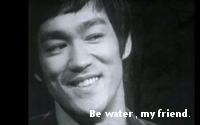
Coming of age, as I did, in the early 1970s, Bruce Lee became one of my personal heroes -- for many reasons -- but until recently, none of
them had to do with the way I think about the media marketplace. Lately, I’ve been thinking a lot about Bruce Lee and how he might have approached real-time media-buying.
Many people know Bruce Lee for his mastery of martial arts, and for his cinematic charisma, but he was also an incredibly insightful philosopher, and much of
what he thought and said could be applied not just to martial arts, but to many other areas of human endeavor, including media.
Like his
martial arts, Bruce Lee’s approach to life was incredibly pragmatic. He used to say, “Simplicity is the shortest distance between two points.” If something works, do it. If it
doesn’t move on and do something else. It was the basis of the martial arts system he developed, Jeet Kune Do, which rejected classical approaches to martial arts training based on rigid,
repetitive routines, katas, styles and forms. Jeet Kune Do, in effect, was a formless system whose power came from freeing its practitioners to adapt as best they could to the circumstances that
confronted them.
advertisement
advertisement
I’m starting to see a similar approach emerge within the media marketplace. it began on the sell-side, but I’m
starting to see it emerge on the demand-side too. OpenX’s new Demand Fusion system is an example of how it works on the supply-side. It breaks out of the rigid, sequential
“daisy-chain” approach publishers have historically used to manage their demand channels. Instead of letting demand cascade over a waterfall until it bottoms out, Demand Fusion looks
simultaneously across all of publishers' demand channels -- from the “premium” inventory sold by their own, direct sales organizations to the chain of third parties (ad networks, and
private and public exchanges) to identify where they can get their greatest yield.
And it’s not always where you think it may be. During
OMMA’s recent RTB Insider Summit on Kiawah Island, SC, OpenX Co-Founder Jason Fairchild shared a powerful anecdote about a “$1,300 bid request” OpenX recently came across for a
publisher. The bid request was made in the auction-based open RTB marketplace, which some people see as commoditizing the value of publishers' inventory and racing it to the bottom of the waterfall.
Fairchild said the $1,300 bid request was likely made by a real-time bidder who had access to some unique data that identified the user as being incredibly valuable to reach with a real-time ad
impression. The bid, he said was, many times greater than what the publisher’s own sales team would sell the impression for -- perhaps $5 at best -- and that it was only able to exist
because of the nature of the RTB marketplace.
Fairchild said OpenX sees many such bid requests in the five-figure range that have gone largely
unseen in the broader marketplace, but he related it because he is trying to stimulate demand from publishers to begin using Demand Fusion so they can manage demand across all their channels
simultaneously, not sequentially, in order to get greater value. In effect, he says, OpenX is trying to make demand flow both up the waterfall.
Recently, I had an opportunity to get briefed by an agency trading desk that is developing a similar approach to the market, but instead of using it to optimize demand channels, it is using it
to optimize supply channels in almost exactly the same way. The trading desk, MDC Partners’ Varick Media Management doesn’t call it that. It calls it its new “product suite,”
but it is exactly the same thing OpenX is doing for publishers with Demand Fusion, but it’s doing it for its agency and brand customers. If you ask me, I think Varick should call its suite
“Supply Fusion,” because it is the perfect counterbalance to what OpenX is doing on the demand-side -- optimizing results based not on a sequential, linear progression of sales processes,
but on where and when the best impressions are available for the best price in the current marketplace.
I’ve always found it interesting
that the ad technology sector has used water metaphors to describe the flow of demand -- down or up -- and that is why after getting briefed by OpenX and Varick I started thinking a lot about
something Bruce Lee once said:
“Be like water making its way through cracks,” Lee said in a television interview just as he was
starting to reach his prime. “Do not be assertive, but adjust to the object, and you shall find a way around or through it. If nothing within you stays rigid, outward things will disclose
themselves.
“Empty your mind, be formless. Shapeless, like water. If you put water into a cup, it becomes the cup. You put water into a bottle and it
becomes the bottle. You put it in a teapot, it becomes the teapot. Now, water can flow or it can crash. Be water, my friend.”